|
Category
|
Kunya Ark Citadel
Construction of Kunya Ark was launched in the 1686-1688 years by Arang Khan, son of Anush Khan. At the end of the XVIII century Kunya Ark became a "city within a city" and was separated from the Ichan-Kala a high wall. Once the fortress consisted of Khan's office, halls for receptions, harem, winter and summer mosques, Mint and outbuildings: stables, warehouses, workshops, etc.
The area near the entrance to the Kunya Ark was used for military parades and training engagements. There was also a special place for the enforcement of sentences and the "zindan" (prison), adjacent to the eastern walls of the Kunya Ark. The premises of the fortress Kunya Ark grouped around courtyards and patios combined system of corridors. In the first small courtyard, adjacent to the former gate, the ambassadors expected the Khan's admission. The second courtyard was seven guns from the gun carriage, and the third was going to Khan's advice. After the corridor was opened very big yard – “kurinishhana”. From “kurinishhana” door in the northwest corner (opposite the entrance) led through the corridor into the harem and the bastion Ak-Sheikh-bobo, which housed a gunpowder warehouse and patrol service. Only a few buildings remain of the once densely built-up area Kunya Ark: the eastern gate to the room for protection, a bastion of Ak-Sheikh-Bobo, "kurinishhona" - facilities for reception, summer and winter mosque and harem.
The first building of Kunya-Ark – “kurinishhona” was built in the 1686-1688 years by Arang Khan and destroyed during the devastating invasion of Iranian troops in the middle of the XVIII century. The modern building was erected in the 1804-1806 years by Iltuzar Khan. Kurinishhona consists of several facilities include an outdoor courtyard “aiwan”, a hall with a throne and lodges in the western part of the court (Khan's treasury, Khan Archives, lounges). “Aivan” of “kurinishhona” was covered with majolica during the reign of Alla-Kuli Khan. Aivan raised on a high platform, has two carved columns that produce a central place where occurred the ceremonial reception, and administering the affairs of state. This site emphasizes the solemnity and formality of the situation in “kurinishhana”. On the stone base of one of its pillars carved poems of Khorezm historian and poet Ogahi.
The territory of the Harem in the Kunya Ark was built up during the reign of Muhammad Rahim Khan II. Harem is located in the northern part of the Kunya Ark. The yard extended from west to east, and built up residential premises - unilinear “aiwans” and one - and two-storey rooms behind them. The premises are close to the harem of residential architecture and devoid of bombast Khan's waiting room. Only Khan's apartments are distinguished by their monumentality and trim. Khan's room more than three rooms of his wives.
|
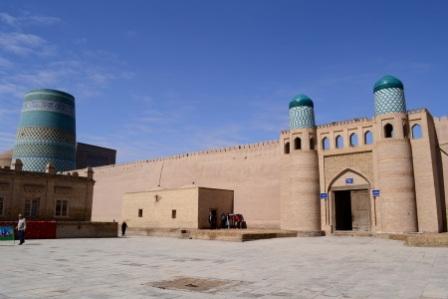 Kunya Ark, which means "Old castle" - a citadel that serve d as a residence for the khans of Khiva. History of the addition of the citadel - is to some extent the history of most of Khiva. Now, however, in the Kunya Ark survived only a few buildings of the XIX century. But it was kind of an ancient fortress “city in the city” - it housed rooms for Khan, his family and dignitaries for the conduct of public service, entertainment, etc.
Kunya Ark, which means "Old castle" - a citadel that serve d as a residence for the khans of Khiva. History of the addition of the citadel - is to some extent the history of most of Khiva. Now, however, in the Kunya Ark survived only a few buildings of the XIX century. But it was kind of an ancient fortress “city in the city” - it housed rooms for Khan, his family and dignitaries for the conduct of public service, entertainment, etc.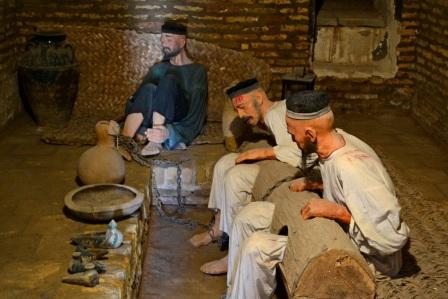 Entrance to the castle gate was decorated like a Palvan-Darwaza. The towers were previously capped lamps with turrets, and the architecture connects them with the walls.
Entrance to the castle gate was decorated like a Palvan-Darwaza. The towers were previously capped lamps with turrets, and the architecture connects them with the walls.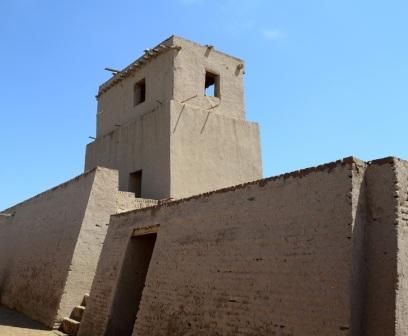 According to legend, the over all strength of Kunya Ark, with its thick wall and semi-towers teeth in X-XI centuries towered castle. Now it remained only the bastion, built not of brick and stone, and of unfired clay. This strange building known as the "Ak-Sheikh-bobo" (The White Sheik). Mainly Ak-Sheikh Bobo played the role of the bastion and an observation tower. And indeed, this is an excellent vantage point: hence are seen from all the ancient Khiva. Appears before the eyes of the city from the east of this tale. Pierces the sky string of minarets, over the flat roofs of houses rise domes of mausoleums and mosques, gleaming blue tiles portals soar over the madrassah galleries shaded loggias, battlements walls interspersed with monumental portals of the city gates. Among the labyrinth streets of Khan's palaces stand surrounding courtyards with ornate “aiwans”.
According to legend, the over all strength of Kunya Ark, with its thick wall and semi-towers teeth in X-XI centuries towered castle. Now it remained only the bastion, built not of brick and stone, and of unfired clay. This strange building known as the "Ak-Sheikh-bobo" (The White Sheik). Mainly Ak-Sheikh Bobo played the role of the bastion and an observation tower. And indeed, this is an excellent vantage point: hence are seen from all the ancient Khiva. Appears before the eyes of the city from the east of this tale. Pierces the sky string of minarets, over the flat roofs of houses rise domes of mausoleums and mosques, gleaming blue tiles portals soar over the madrassah galleries shaded loggias, battlements walls interspersed with monumental portals of the city gates. Among the labyrinth streets of Khan's palaces stand surrounding courtyards with ornate “aiwans”.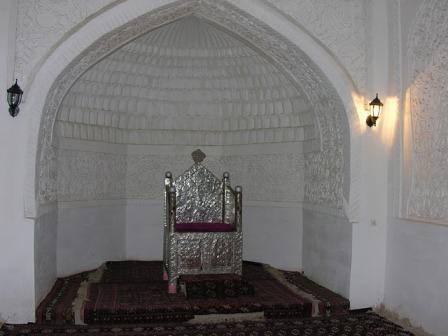 In the middle of the courtyard is a circular elevation, where there was a “yurt” (tent), in which Khan took the ambassadors of the nomadic tribes. Khan was at the throne of the southern wall of the throne room by a decorative semi-dome. It was made of wood and covered with a thin plate of silver carvings, made in 1816 by Khiva master Muhammad. On silver plates, ornamental medallions were minted with fine patterns on a red background, and they skillfully woven engraved verses from the Koran and the good wishes reign of the ruler. The throne is of interest as an example of coinage of silver and is currently stored in the Armory Museum in Moscow.
In the middle of the courtyard is a circular elevation, where there was a “yurt” (tent), in which Khan took the ambassadors of the nomadic tribes. Khan was at the throne of the southern wall of the throne room by a decorative semi-dome. It was made of wood and covered with a thin plate of silver carvings, made in 1816 by Khiva master Muhammad. On silver plates, ornamental medallions were minted with fine patterns on a red background, and they skillfully woven engraved verses from the Koran and the good wishes reign of the ruler. The throne is of interest as an example of coinage of silver and is currently stored in the Armory Museum in Moscow.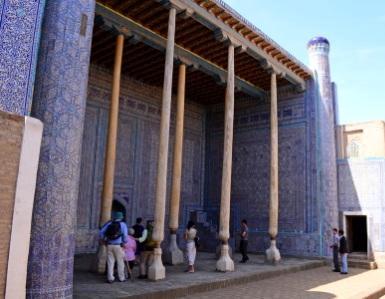 Mint was built during the reign of Muhammad Rahim Khan I, which was held in the Khanate of tax reform, created customs, began minting gold coins. It was built in conjunction with summer and winter mosque. Against the backdrop of a simple, devoid of decoration of the hall of the mosque stands the winter ceremonial finish its part of the summer. This “aiwan” with two rows of columns, painted blue, green and red colors. Its walls, "mihrab" (niche indicating the direction to Mecca) and the "minbar" (elevation for the sermon), and the towers on the edges completely covered with majolica tiles, decorated complex floral pattern. The courtyard of the mosque is small, moreover, much of it is occupied by domes premises where coins were minted.
Mint was built during the reign of Muhammad Rahim Khan I, which was held in the Khanate of tax reform, created customs, began minting gold coins. It was built in conjunction with summer and winter mosque. Against the backdrop of a simple, devoid of decoration of the hall of the mosque stands the winter ceremonial finish its part of the summer. This “aiwan” with two rows of columns, painted blue, green and red colors. Its walls, "mihrab" (niche indicating the direction to Mecca) and the "minbar" (elevation for the sermon), and the towers on the edges completely covered with majolica tiles, decorated complex floral pattern. The courtyard of the mosque is small, moreover, much of it is occupied by domes premises where coins were minted.














